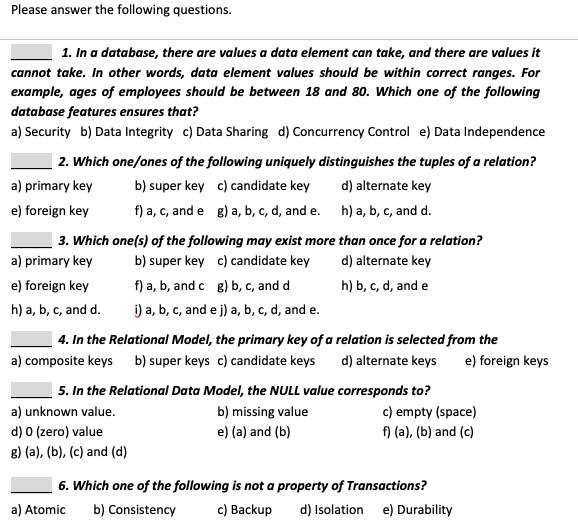1. In a database, there are values a data element can take, and there are values it cannot take. In other words, data element values should be within correct ranges. For example, ages of employees should be between 18 and 80. Which one of the following database features ensures that? a) Security b) Data Integrity c) Data Sharing d) Concurrency Control e) Data Independence |2. Which one/ones of the following uniquely distinguishes the tuples of a relation? a) primary key b) super key c) candidate key d) alternate key e) foreign key f) a, c, and e 8) a, b, c, d, and e. h) a, b, c, and d. 3. Which one(s) of the following may exist more than once for a relation? a) primary key b) super key c) candidate key d) alternate key f) a, b, and c 8) b, c, and d i) a, b, c, and e j) a, b, c, d, and e. e) foreign key h) b, c, d, and e h) a, b, c, and d. | 4. In the Relational Model, the primary key of a relation is selected from the a) composite keys b) super keys c) candidate keys d) alternate keys e) foreign keys 5. In the Relational Data Model, the NULL value corresponds to? c) empty (space) f) (a), (b) and (c) a) unknown value. b) missing value d) 0 (zero) value e) (a) and (b) 8) (a), (b), (c) and (d)
1. In a database, there are values a data element can take, and there are values it cannot take. In other words, data element values should be within correct ranges. For example, ages of employees should be between 18 and 80. Which one of the following database features ensures that? a) Security b) Data Integrity c) Data Sharing d) Concurrency Control e) Data Independence |2. Which one/ones of the following uniquely distinguishes the tuples of a relation? a) primary key b) super key c) candidate key d) alternate key e) foreign key f) a, c, and e 8) a, b, c, d, and e. h) a, b, c, and d. 3. Which one(s) of the following may exist more than once for a relation? a) primary key b) super key c) candidate key d) alternate key f) a, b, and c 8) b, c, and d i) a, b, c, and e j) a, b, c, d, and e. e) foreign key h) b, c, d, and e h) a, b, c, and d. | 4. In the Relational Model, the primary key of a relation is selected from the a) composite keys b) super keys c) candidate keys d) alternate keys e) foreign keys 5. In the Relational Data Model, the NULL value corresponds to? c) empty (space) f) (a), (b) and (c) a) unknown value. b) missing value d) 0 (zero) value e) (a) and (b) 8) (a), (b), (c) and (d)
Database Systems: Design, Implementation, & Management
11th Edition
ISBN:9781285196145
Author:Steven, Steven Morris, Carlos Coronel, Carlos, Coronel, Carlos; Morris, Carlos Coronel and Steven Morris, Carlos Coronel; Steven Morris, Steven Morris; Carlos Coronel
Publisher:Steven, Steven Morris, Carlos Coronel, Carlos, Coronel, Carlos; Morris, Carlos Coronel and Steven Morris, Carlos Coronel; Steven Morris, Steven Morris; Carlos Coronel
Chapter10: Transaction Management And Concurrency Control
Section: Chapter Questions
Problem 1P
Related questions
Question
pls be quick

Transcribed Image Text:Please answer the following questions.
1. In a database, there are values a data element can take, and there are values it
cannot take. In other words, data element values should be within correct ranges. For
example, ages of employees should be between 18 and 80. Which one of the following
database features ensures that?
a) Security b) Data Integrity c) Data Sharing d) Concurrency Control e) Data Independence
2. Which one/ones of the following uniquely distinguishes the tuples of a relation?
a) primary key
b) super key c) candidate key
d) alternate key
e) foreign key
f) a, c, and e g) a, b, c, d, and e. h) a, b, c, and d.
3. Which one(s) of the following may exist more than once for a relation?
a) primary key
b) super key c) candidate key
d) alternate key
f) a, b, and c g) b, c, and d
i) a, b, c, and e j) a, b, c, d, and e.
e) foreign key
h) b, c, d, and e
h) a, b, c, and d.
4. In the Relational Model, the primary key of a relation is selected from the
a) composite keys b) super keys c) candidate keys
d) alternate keys
e) foreign keys
5. In the Relational Data Model, the NULL value corresponds to?
c) empty (space)
f) (a), (b) and (c)
a) unknown value.
b) missing value
d) 0 (zero) value
e) (a) and (b)
8) (a), (b), (c) and (d)
6. Which one of the following is not a property of Transactions?
c) Backup
a) Atomic
b) Consistency
d) Isolation e) Durability
Expert Solution
This question has been solved!
Explore an expertly crafted, step-by-step solution for a thorough understanding of key concepts.
Step by step
Solved in 2 steps

Knowledge Booster
Learn more about
Need a deep-dive on the concept behind this application? Look no further. Learn more about this topic, computer-science and related others by exploring similar questions and additional content below.Recommended textbooks for you

Database Systems: Design, Implementation, & Manag…
Computer Science
ISBN:
9781285196145
Author:
Steven, Steven Morris, Carlos Coronel, Carlos, Coronel, Carlos; Morris, Carlos Coronel and Steven Morris, Carlos Coronel; Steven Morris, Steven Morris; Carlos Coronel
Publisher:
Cengage Learning

Database Systems: Design, Implementation, & Manag…
Computer Science
ISBN:
9781285196145
Author:
Steven, Steven Morris, Carlos Coronel, Carlos, Coronel, Carlos; Morris, Carlos Coronel and Steven Morris, Carlos Coronel; Steven Morris, Steven Morris; Carlos Coronel
Publisher:
Cengage Learning